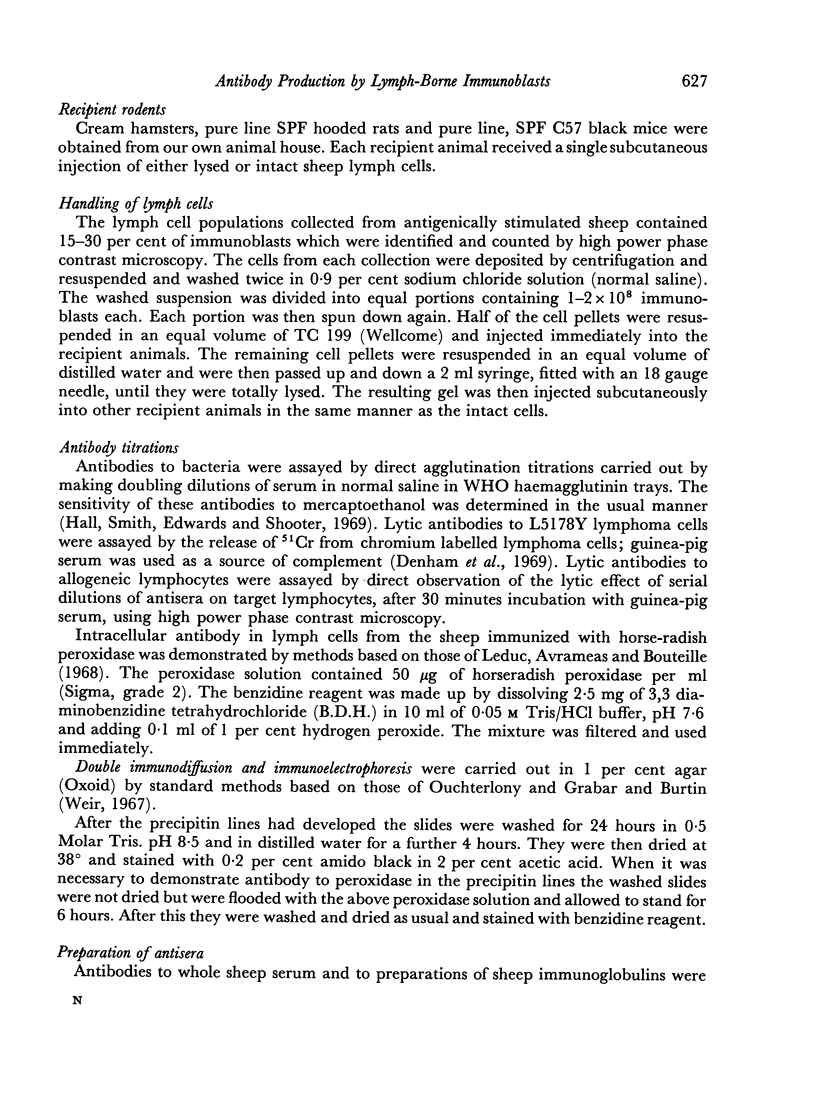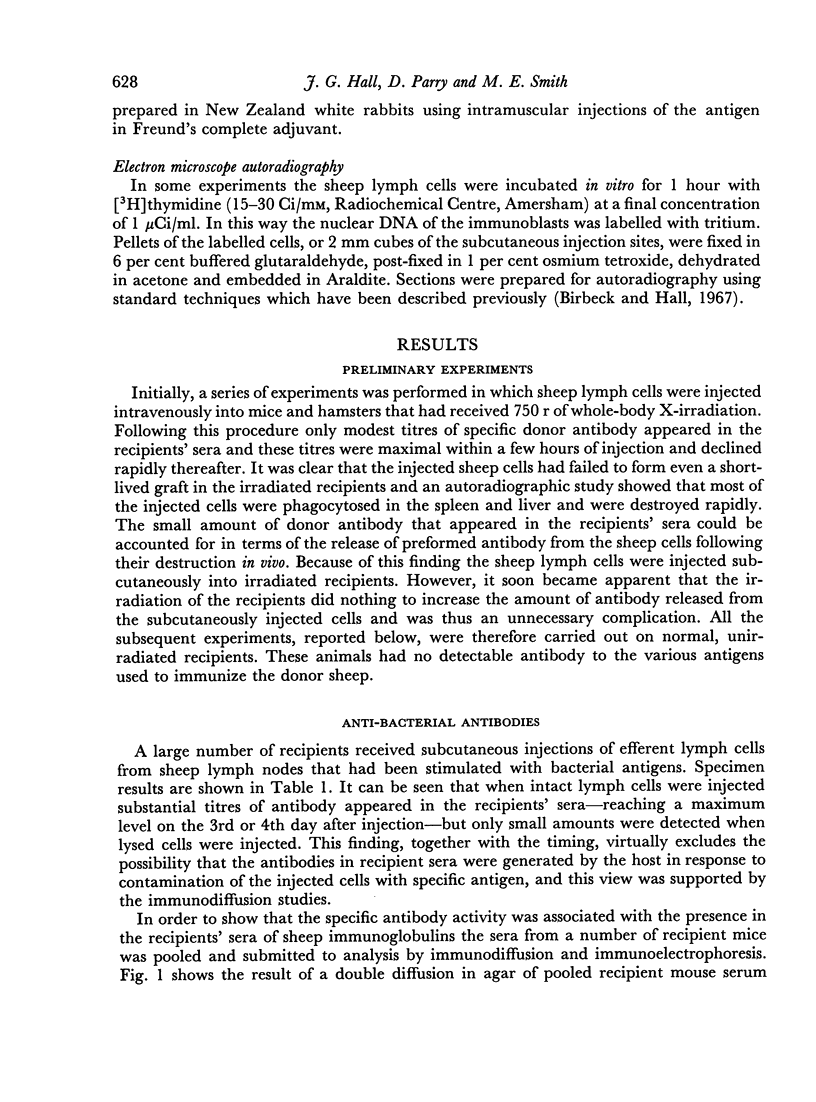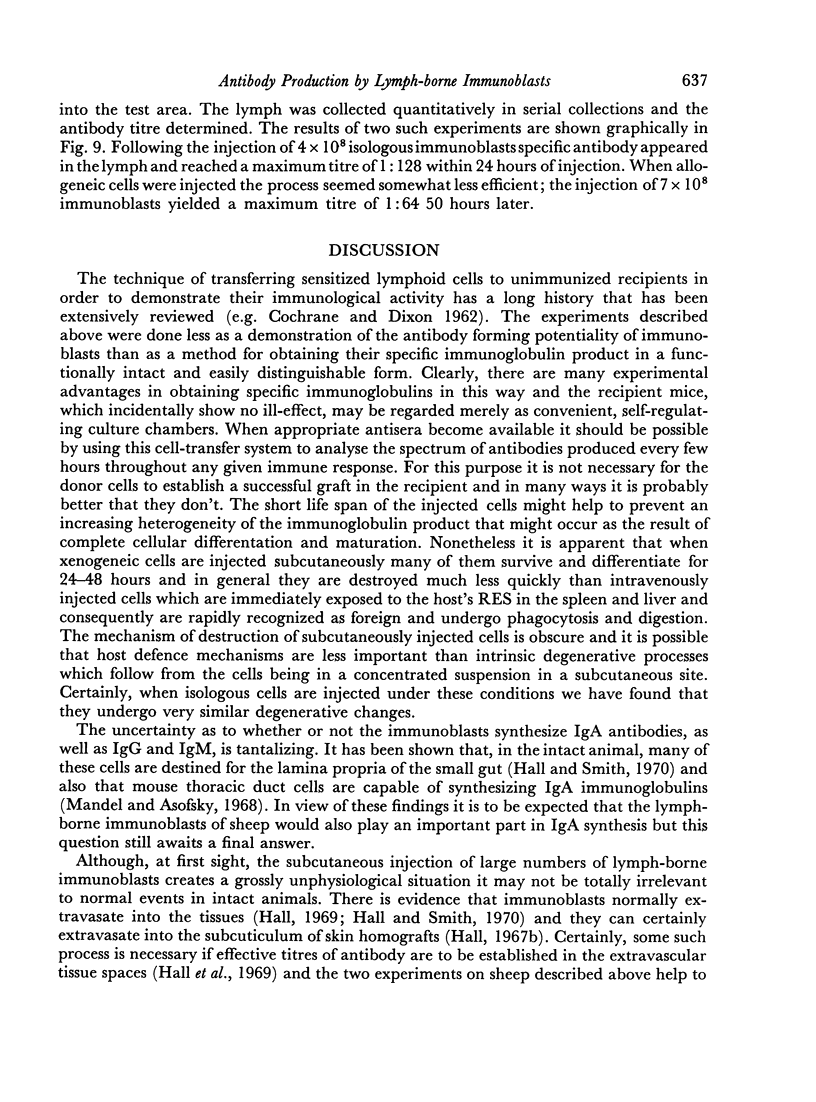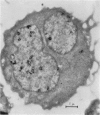Abstract
Efferent lymph was collected from individual lymph nodes of unanaesthetized sheep following stimulation of the nodes with a variety of antigens. At the height of the immune responses (i.e. 80–120 hours after stimulation) 15–30 per cent of the lymph cells were large, basophilic immunoblasts. Lymph cells collected during these times were washed and injected subcutaneously into small laboratory rodents (usually C57 black mice); each recipient received a single injection of lymph cells containing 1–2 × 108 immunoblasts. Between 24 and 100 hours later the recipients were killed and exsanguinated. By the latter time substantial titres of specific agglutinating or lytic antibodies were demonstrable in the sera of the recipients and immunodiffusion and immunoelectrophoresis studies confirmed the presence in these sera of sheep immunoglobulins. Only trivial titres of antibody appeared in the recipients' sera when lysed lymph cells had been injected and no antibody or immunoglobulin was detectable following the injection of normal small lymphocytes from unstimulated or hyperimmune sheep.
An autoradiographic, electron microscope study showed that although many of the injected immunoblasts degenerated rapidly a significant proportion survived long enough to develop lamellar endoplasmic reticulum.
It was concluded that some of the injected cells survived long enough to synthesize and secrete specific antibody; on the basis of mercaptoethanol sensitivity it was concluded that both 19 and 7S antibodies were produced.
When sheep immunoblasts were injected subcutaneously into isogeneic or allogeneic sheep specific antibody appeared in the local tissue fluid and reached a relatively high titre some 50 hours after the injection.
Full text
PDF













Images in this article
Selected References
These references are in PubMed. This may not be the complete list of references from this article.
- Birbeck M. S., Hall J. G. Transformation, in vivo, of basophilic lymph cells into plasma cells. Nature. 1967 Apr 8;214(5084):183–185. doi: 10.1038/214183a0. [DOI] [PubMed] [Google Scholar]
- Cunningham A. J., Smith J. B., Mercer E. H. Antibody formation by single cells from lymph nodes and efferent lymph of sheep. J Exp Med. 1966 Oct 1;124(4):701–714. doi: 10.1084/jem.124.4.701. [DOI] [PMC free article] [PubMed] [Google Scholar]
- Denham S., Hall J. G., Wolf A., Alexander P. The nature of the cytotoxic cells in lymph following primary antigenic challenge. Transplantation. 1969 Mar;7(3):194–203. doi: 10.1097/00007890-196903000-00006. [DOI] [PubMed] [Google Scholar]
- HALL J. G., MORRIS B. The lymph-borne cells of the immune response. Q J Exp Physiol Cogn Med Sci. 1963 Jul;48:235–247. doi: 10.1113/expphysiol.1963.sp001660. [DOI] [PubMed] [Google Scholar]
- HALL J. G., MORRIS B. The output of cells in lymph from the popliteal node of sheep. Q J Exp Physiol Cogn Med Sci. 1962 Oct;47:360–369. doi: 10.1113/expphysiol.1962.sp001620. [DOI] [PubMed] [Google Scholar]
- Hall J. G. A method for collecting lymph from the prefemoral lymph node of unanaesthetised sheep. Q J Exp Physiol Cogn Med Sci. 1967 Apr;52(2):200–205. doi: 10.1113/expphysiol.1967.sp001902. [DOI] [PubMed] [Google Scholar]
- Hall J. G. Effector mechanisms in immunity. Lancet. 1969 Jan 4;1(7584):25–28. doi: 10.1016/s0140-6736(69)90988-x. [DOI] [PubMed] [Google Scholar]
- Hall J. G., Morris B., Moreno G. D., Bessis M. C. The ultrastructure and function of the cells in lymph following antigenic stimulation. J Exp Med. 1967 Jan 1;125(1):91–110. doi: 10.1084/jem.125.1.91. [DOI] [PMC free article] [PubMed] [Google Scholar]
- Hall J. G., Smith M. E., Edwards P. A., Shooter K. V. The low concentration of macroglobulin antibodies in peripheral lymph. Immunology. 1969 Jun;16(6):773–778. [PMC free article] [PubMed] [Google Scholar]
- Hall J. G., Smith M. E. Homing of lymph-borne immunoblasts to the gut. Nature. 1970 Apr 18;226(5242):262–263. doi: 10.1038/226262a0. [DOI] [PubMed] [Google Scholar]
- Leduc E. H., Avrameas S., Bouteille M. Ultrastructural localization of antibody in differentiating plasma cells. J Exp Med. 1968 Jan 1;127(1):109–118. doi: 10.1084/jem.127.1.109. [DOI] [PMC free article] [PubMed] [Google Scholar]
- Mandel M. A., Asofsky R. Studies of thoracic duct lymphocytes of mice. I. Immunoglobulin synthesis in vitro. J Immunol. 1968 Feb;100(2):363–370. [PubMed] [Google Scholar]










